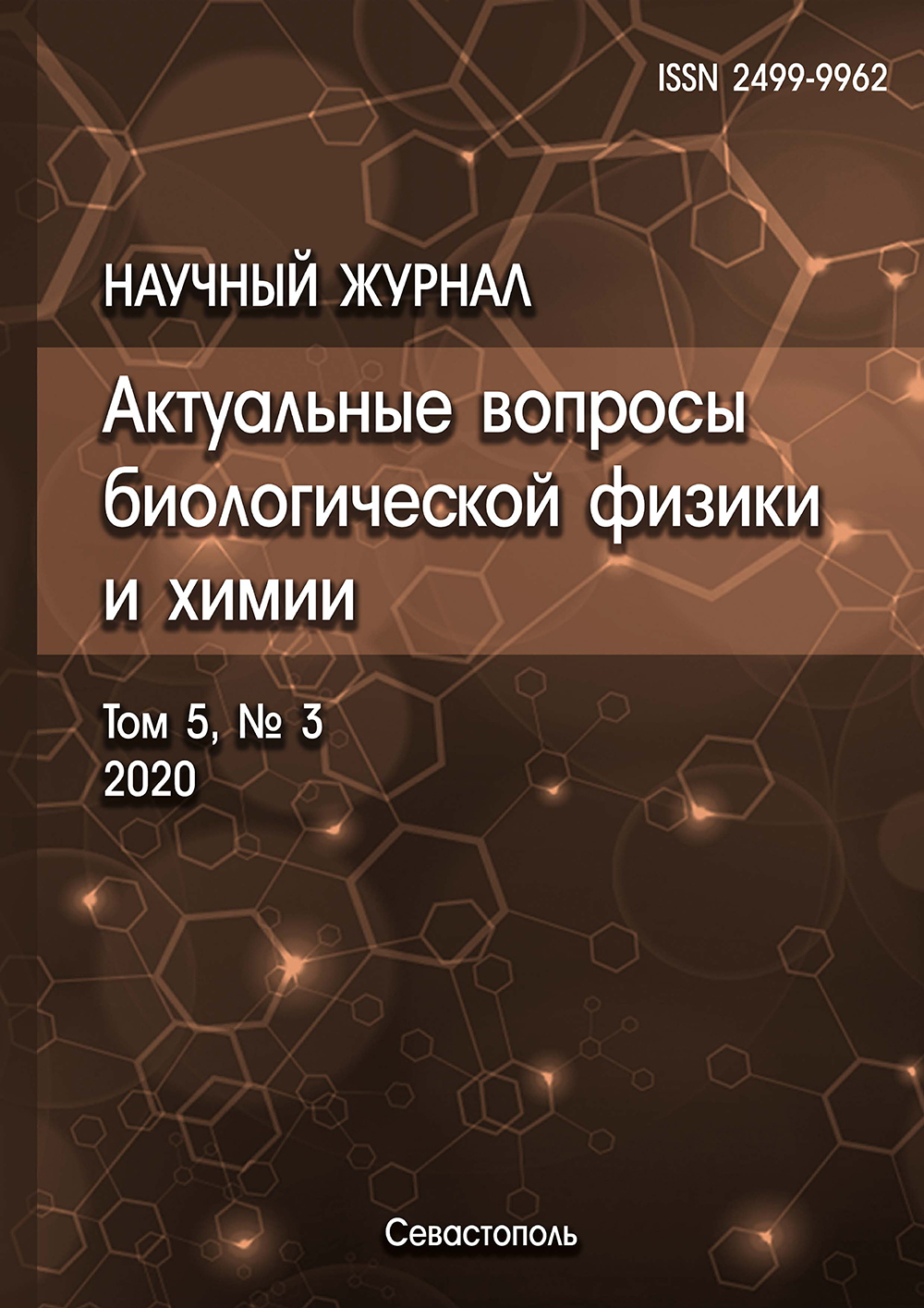Russian Federation
The research is related to electrochemical processes in hydrogel media. An electrochemical model of electroactive phenothiazine dye toluidine blue (TB) diffusion in the medium of a combined alginate-gelatin gel during pepsin proteolysis was studied. The data of cyclic voltammetry (CVA) of the dye in an acidic medium are presented. The TB diffusion coefficient was calculated. It was shown, the curves of cyclic voltammetry had qualitative and quantitative changes compared to data in neutral medium. The dye diffusion in hydrogels with various compositions was studied using the CVA method. Calculations of the TB diffusion coefficient in gel media with different alginate/gelatin ratios were performed. The influence of the hydrogel composition on the character of volt-ampere curves that characterize the redox transformations of an electroactive label was elucidated. The electrochemical characteristics of toluidine blue in an alginate-gelatin hydrogel with a 1:3 component ratio in the presence of pepsin had the value of the potential difference of the oxidation and reduction peaks as ∆E = 120,3 mV, as well as the ratio of peak currents: Ipox/Ipred = 1,08 at Ipred = 8,99 µA and Ipox = 9,70 µA. The ratio shows that the system is close to reversible electrochemical behavior. The addition of pepsin leads to an acceleration of dye diffusion. It is quantified in a dynamic of current values and an increase in the value of the effective diffusion coefficient. The model can be used to simulate some elements of inflammatory reactions in electrode, to study the quality of enzyme preparations, to evaluate the diffusion properties of various gel-forming agents and their resistance to proteolysis.
toluidine blue, pepsin, gelatin, alginate, cyclic voltammetry
1. Shumyantseva V.V., Bulko T.V., Suprun E.V., Kuzikov A.V., Agafonova L.E., Archakov A.I. Electrochemical methods in biomedical studies. Biochem. Suppl. Ser. B Biomed. Chem., 2015, vol. 9, no. 3, pp. 228-243.
2. Cherenkov I.A. Raevskih K.S., Sergeev V.G., Krivilev M.D. Modelirovanie proteaznoy aktivnosti s ispol'zovaniem elektrohimicheskogo interfeysa. Aktual'nye voprosy biologicheskoy fiziki i himii, 2018, t. 3, № 2, S. 422-426. EDN: https://elibrary.ru/VCCIFR
3. Stoytcheva M., Zlatev R., Cosnier S., Arredondo M. Square wave voltammetric determination of trypsin activity. Electrochim. Acta, Elsevier, 2012, vol. 76, pp. 43-47.
4. Fonseca K.B., Bidarra S.J., Oliveira M.J., Granja P.L., Barrias C.C. Molecularly designed alginate hydrogels susceptible to local proteolysis as three-dimensional cellular microenvironments. Acta Biomater. Acta Materialia Inc., 2011, vol. 7, no. 4, pp. 1674-1682.
5. Cherenkov I.A., Kropacheva T.N., Perevozchikov E.A., Sergeev V.G. Elektrohimicheskaya ocenka metaboli-cheskoy aktivnosti kletok rodokokkov, immobilizovannyh na planarnom grafitovom elektrode. Tehnologii zhivyh sistem, 2015, t. 12, № 2, c. 12-19. EDN: https://elibrary.ru/UAHCWD
6. Trevors J.T., Pollack G.H. Hypothesis: The origin of life in a hydrogel environment. Prog. Biophys. Mol. Biol. 2005. vol. 89, no. 1. pp. 1-8.
7. Mishra S., Scarano F.J., Calvert P. Entrapment of Saccharomyces cerevisiae and 3T3 fibroblast cells into blue light cured hydrogels. J. Biomed. Mater. Res. - Part A, 2012, vol. 100 A, no. 10, pp. 2829-2838.
8. González-Fernández E., Avlonitis N., Murray A. F., Mount A.R., Bradley M. Methylene blue not ferrocene: Optimal reporters for electrochemical detection of protease activity. Biosens. Bioelectron. Elsevier, 2016, vol. 84, pp. 82-88.
9. Deng D., Hao Y., Yang S., Han Q., Liu L., Xiang Y., Tu F., Xia N. A signal-on electrochemical biosensor for evaluation of caspase-3 activity and cell apoptosis by the generation of molecular electrocatalysts on graphene electrode surface for water oxidation. Sensors Actuators, B Chem. Elsevier, 2019, vol. 286, pp. 415-420.
10. Allavena P., Garlanda C., Borrello M. G., Sica A., Mantovani A. Pathways connecting inflammation and cancer. Curr. Opin. Genet. Dev., 2008, vol. 18, no. 1, pp. 3-10.
11. Sergeev V.G., Sergeeva T.N., Chuchkov V.M. Kletochnye mehanizmy hronicheskogo neyrovospaleniya. Morfologicheskie vedomosti, 2014, № 4, c. 31-36.
12. Oda K., Luo Y., Yoshihara A., Ishido, Y., Sekihata K., Usukura K., Sue M., Hiroi N., Hirose T., Suzuki K. Follicular thyroglobulin induces cathepsin H expression and activity in thyrocytes. Biochem. Biophys. Res. Commun. Elsevier, 2017, vol. 483, no. 1, pp. 541-546.
13. Dunn J.T., Dunn D. Update on intrathyroidal iodine metabolism. Thyroid, 2001, vol. 11, no. 5, pp. 407-414.
14. Elektroanaliticheskie metody, red. Shol'c F. M.: Binom «Laboratoriya znaniy», 2010, 326 s.
15. Goudie M.J. et al. Investigation of Diffusion Characteristics through Microfluidic Channels for Passive Drug Delivery Applications. J. Drug Deliv., 2016, vol. 2016, pp. 1-9.










